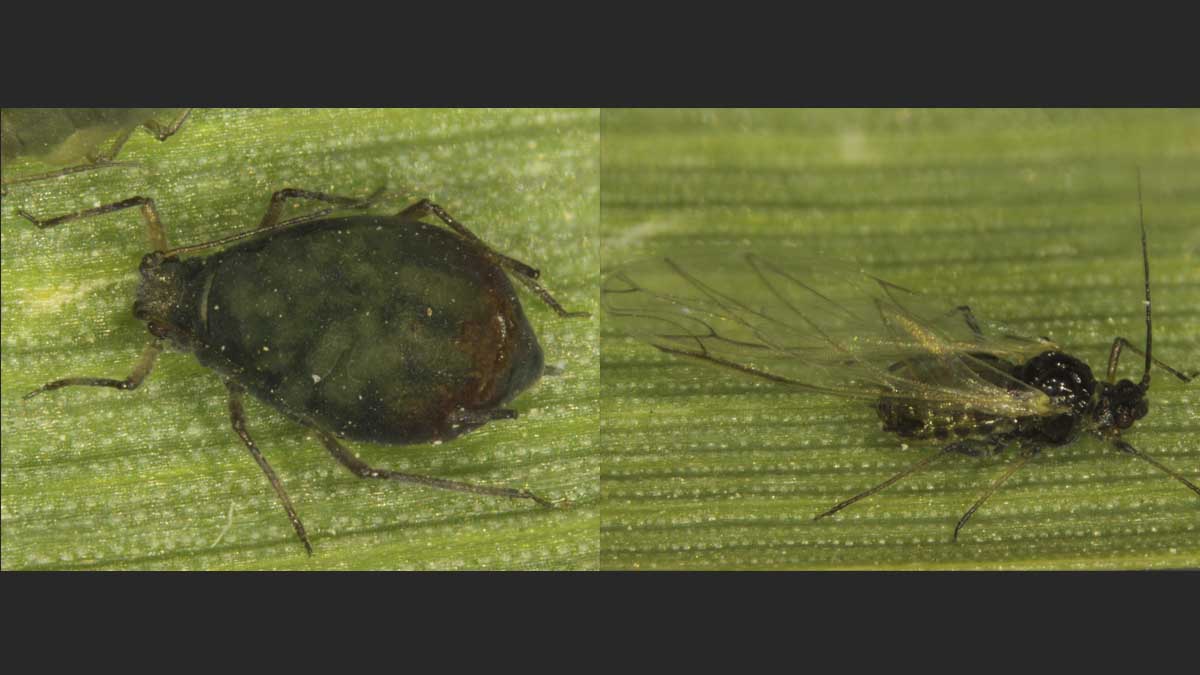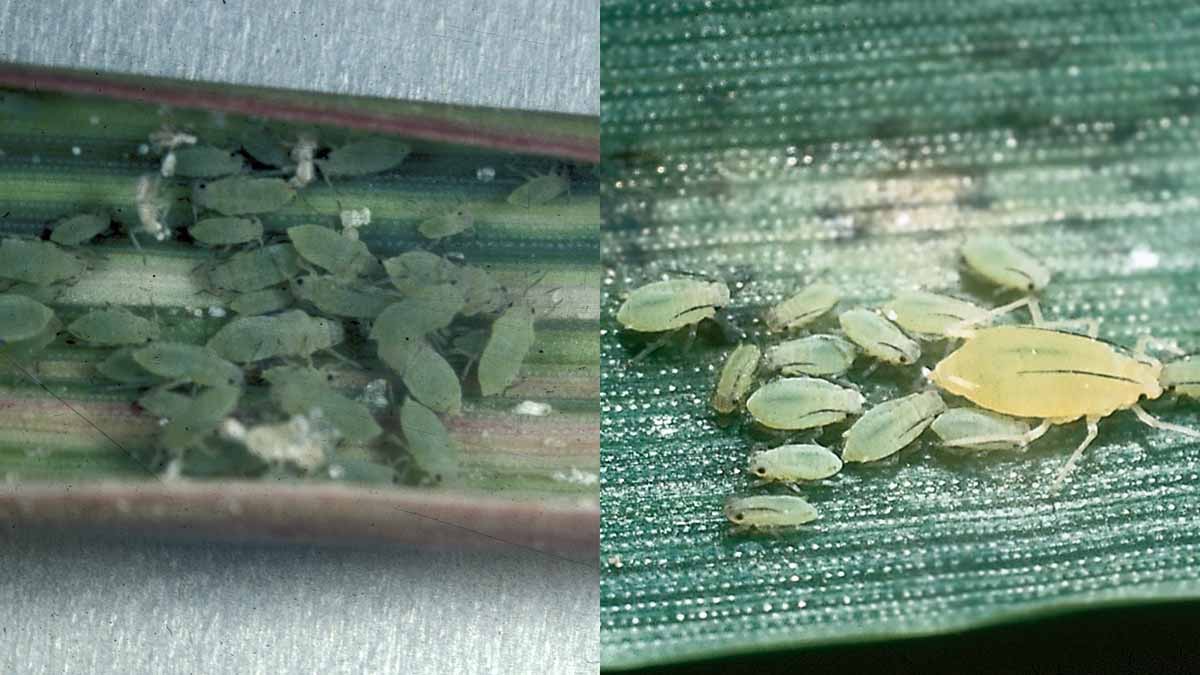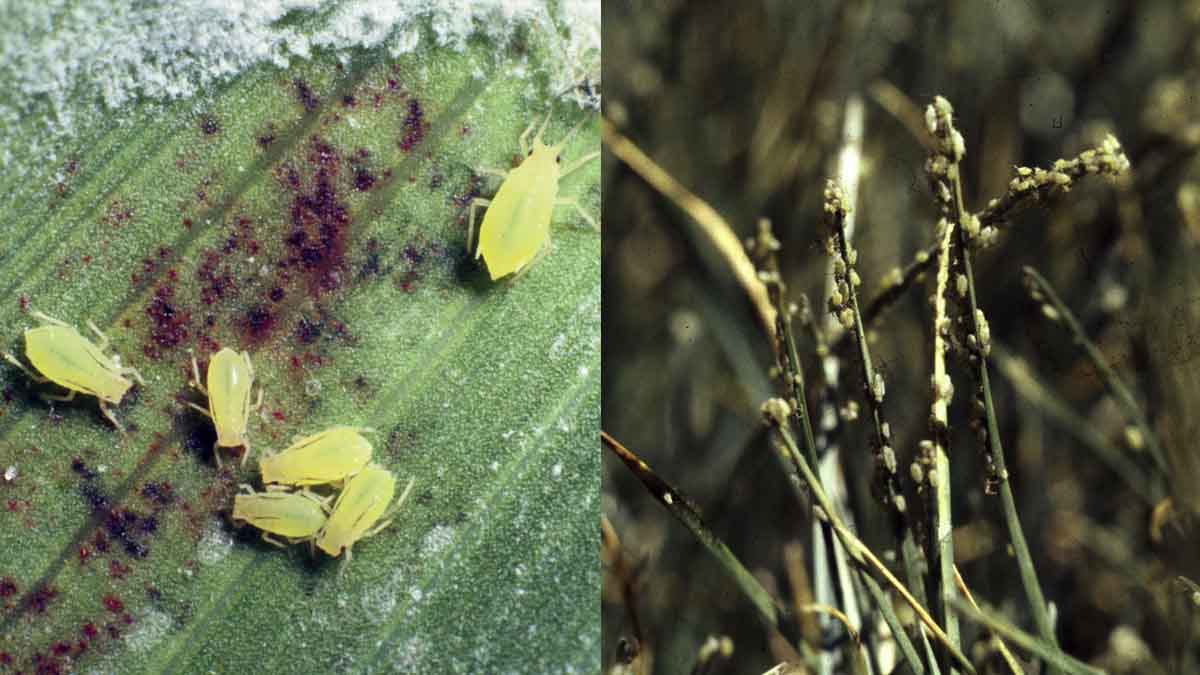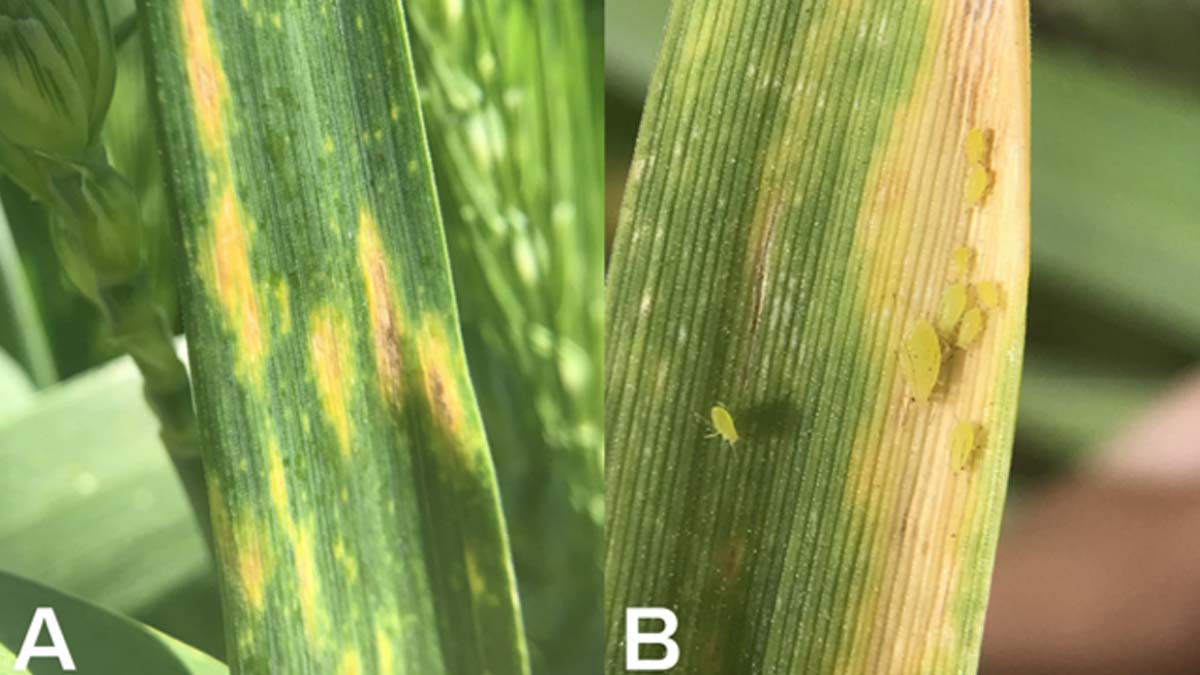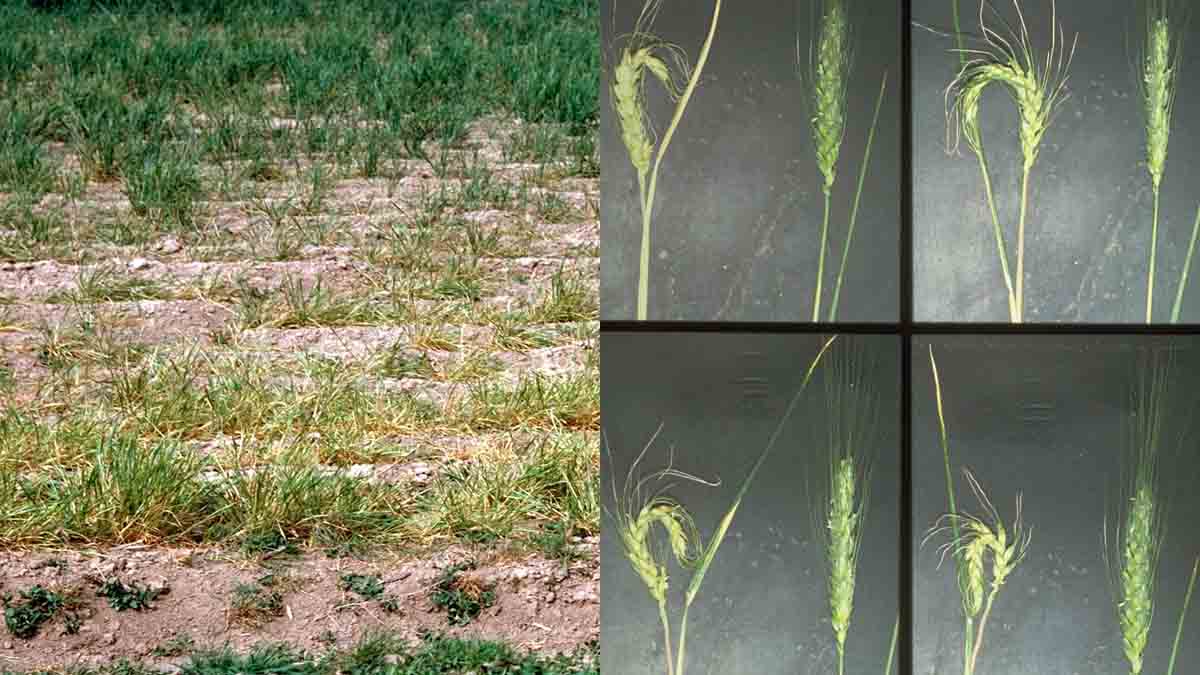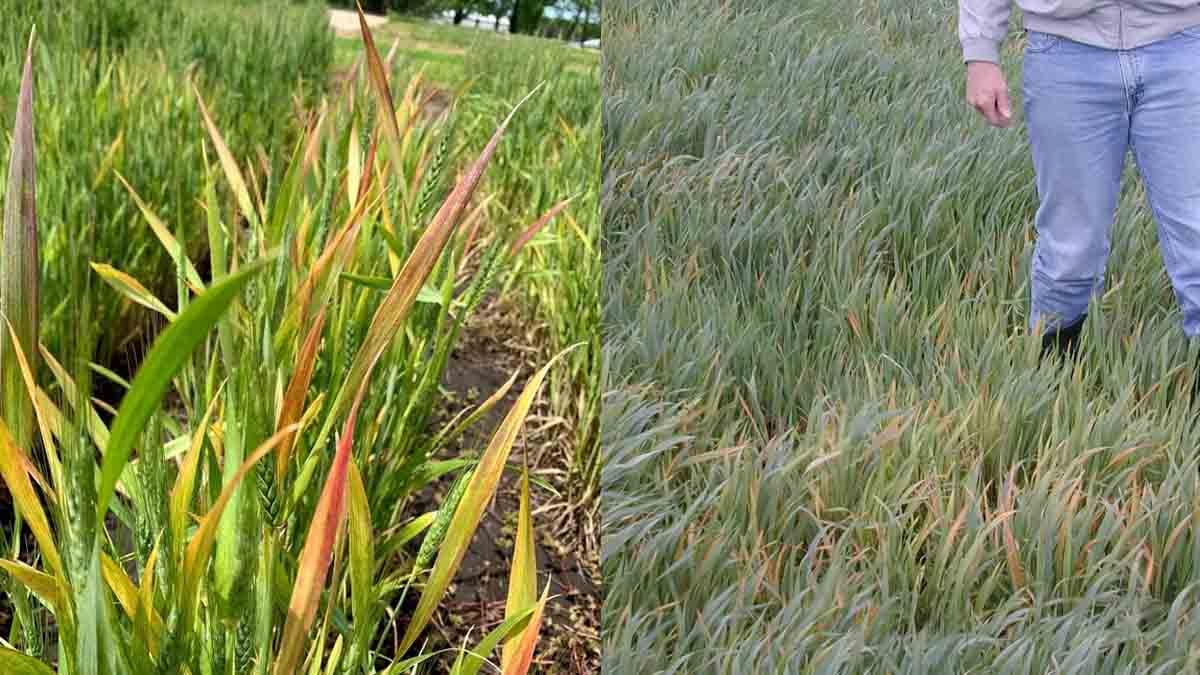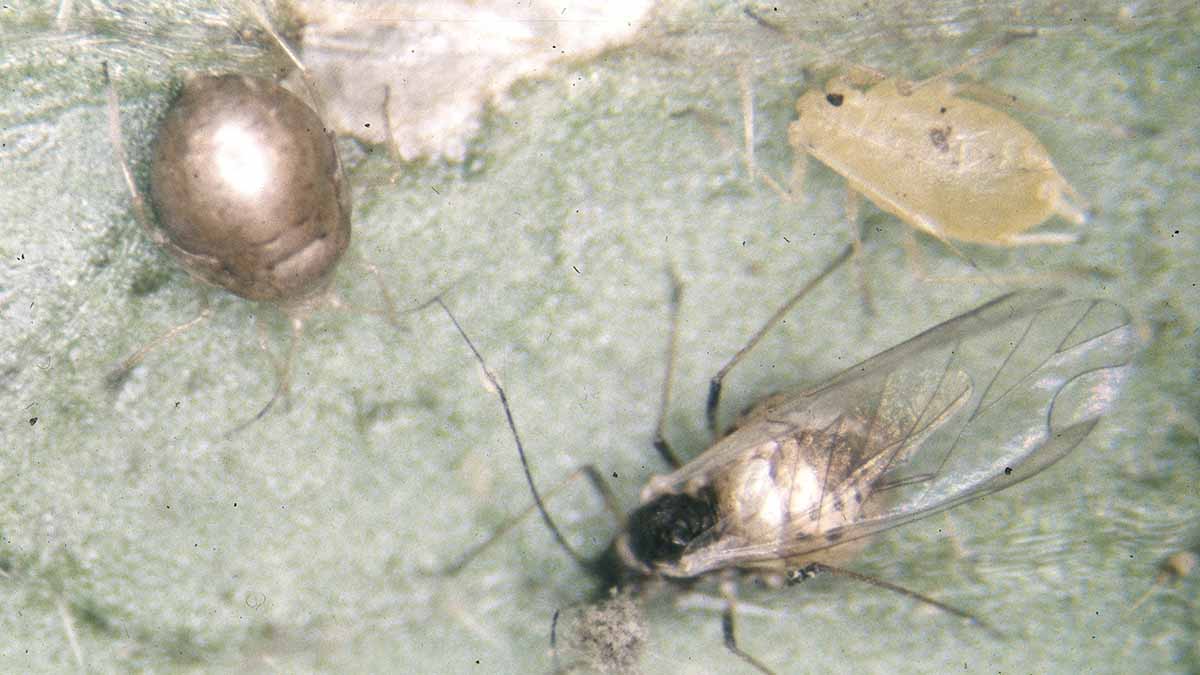Aphids
Pest Common Name
- Bird Cherry-Oat Aphid (Rhopalosiphum padi)
- Corn Leaf Aphid (Rhopalosiphum maidis)
- English Grain Aphid (Sitobion avenae)
- Cereal Grass Aphid (Metopolophium festucae cerealium)
- Rose-grain Aphid (Metopolophium dirhodum)
- Greenbug (Schizaphis graminum)
- Russian Wheat Aphid (Diuraphis noxia)
- Grains: All major cereals including barley, wheat, and oats; Russian wheat aphid is usually only found on barley and wheat
- Other crops: Most species can also be found on corn, pasture grasses
- Non-crops: Most species can be found on a variety of grasses, occasionally woody plants
In general, aphids are small, 1/32-1/8 inch (0.8-3.2 mm), plant-feeding insects with soft bodies. They are usually oval to pear-shaped and may be green, black, yellow or reddish in color. While immature aphids are always wingless, wings may be present or absent in adults (Figure 1). One of the best ways to distinguish aphids from other arthropods is the presence of cornicles (also called siphunculi), which are paired, rear-facing “tailpipe” like structures situated toward the back of the body. However, note that in some species, including the Russian wheat aphid, the cornicles are very small.
Not every aphid found on a cereal crop is necessarily colonizing (living and reproducing on) the crop, or even feeding on it. Some aphids may just be “passing through” as they search for their desired host plants. Colonizing and non-colonizing can largely be distinguished from one another by the presence or absence of wings on the aphids. Colonizing species will usually form clusters of wingless immature and adult aphids on the cereal crop, while non-colonizing species will usually be sparse and winged (Figure 2).
There are several species of aphids that colonize cereal crops in Idaho. Multiple species often co-occur in the same field, and differentiating between these species in the field can be difficult. One exception is the Russian wheat aphid, which can be easily identified by its lack of conspicuous cornicles (“tailpipe” like structures situated toward the back of the body) (Figure 3), in contrast to the much longer, easily noticeable cornicles found in other cereal-colonizing species. A hand lens or microscope may be necessary for accurate species-level identification. Correct identification of aphid species can be important for making optimal management choices. More information and identification resources for cereal colonizing aphids can be found in this University of Idaho Extension bulletin, BUL1026 (pdf) or this University of Nebraska-Lincoln Extension publication, G1284 (pdf). However, species-level identification can be extremely challenging, so consulting local university Extension personnel is encouraged.



Biology
Aphids feed by piercing plants with needle-like mouthparts and sucking out nutrient-rich sap. Most cereal colonizing aphids feed on a diverse array of grasses and grass-like plants such as sedges, rushes and cattails. Depending on the species, aphids may use a single host plant species year-round or use different hosts during different seasons. For aphid species that use different hosts depending on the season (a strategy called host alternation) — they usually use a woody host plant in winter and a cereal or grass in summer. Examples of host alternating aphids include the rose-grain aphid and bird cherry-oat aphid, which use roses and chokecherry (Prunus virginiana) or bird cherry (Prunus padus) as winter hosts, respectively, while colonizing cereal crops and grasses in the summer. The other cereal colonizing aphids listed above do not alternate host plants and spend their entire lives on cereals and/or other grasses.
During most of the year, aphids undergo exclusively asexual reproduction — female aphids give birth to clones of themselves without mating — a strategy that allows for rapid population growth. Sexual reproduction occurs only on winter hosts (in the case of host-alternating species) or during certain times of the year or under specific environmental conditions (in the case of single-host species).
Cereal colonizing aphids generally overwinter as eggs laid on or near a suitable host plant. Female aphids known as fundatrices (singular fundatrix) hatch from the eggs and give birth to new colonies in spring. Aphids may move to cereal crops from other host plants at any point during the growing season, with late summer and fall often being the most problematic times for aphid migrations.
Damage
The characteristics and severity of damage vary by species of aphid and intensity of infestation. Damage induced by cereal colonizing aphids can be broken down into two types: physical effects caused by the feeding activity of the aphids and transmission of plant pathogenic viruses.
In terms of physical effects, heavy infestations of aphids may cause a decrease in nutrient levels within the afflicted cereal crop (e.g. decreases in protein content), reduction in yield, leaf necrosis (death) and leaf discoloration. The pattern and progression of leaf discoloration may provide some insight into the species responsible for the damage.
Greenbug aphids cause discoloration of leaves, starting with small, reddish spots in spring which expand into yellow or red patches, potentially causing leaf death and spreading widely throughout the field (Figure 4). Cereal grass aphids induce also induce leaf yellowing and death (Figure 5). Feeding of the Russian wheat aphid causes discoloration that starts as white, yellow or purple streaks and progresses into yellowing that resembles the effects of drought-stress (Figure 6). Russian wheat aphid feeding also causes leaves to curl tightly around the aphid colony, creating a space that shelters the aphids. Additionally, seed heads and/or flag leaves may twist and curl, potentially preventing proper emergence and reducing yield (Figure 6). Heavy infestations of Russian wheat aphid may stunt growth and cause losses of entire fields if the infestation is not detected and controlled early enough.
The rose-grain aphid, English grain aphid and corn leaf aphid do not usually cause noticeable physical damage. The bird cherry-oat aphid also typically does not cause physical damage, but rarely may induce curling of the flag leaf in a manner that traps the awns, giving a “fish-hook” appearance or occasionally leaf yellowing.



The other and often more serious form of damage inflicted by aphids is the spread of plant-pathogenic viral diseases. While there are several viruses that may be vectored to cereals by aphids, Barley yellow dwarf virus (BYDV) is the most significant in Idaho. Of the cereal colonizing aphids listed at the beginning of the profile, all except the Russian wheat aphid are potential vectors of BYDV. Of the BYDV vectors, the bird cherry-oat aphid and the English grain aphid are generally considered to be the most significant in Idaho, while the others are inefficient or minor vectors. BYDV affects many crops in the grass family, including barley, wheat and oats. Though symptoms of the virus can vary, the most common are stunting of leaves, roots and seed heads, and a yellow and/or reddish discoloration of the leaf tips that slowly spreads down the leaves as the infection progresses (Figure 7). While BYDV can impact either winter or spring cereal crops, it is a larger concern for winter crops planted in the fall. On average, BYDV causes yield reductions between 10-20% in infected fields, though losses as high as 70-100% have been reported when infection occurs early after plant emergence. More information can be found with publication: Barley Yellow Dwarf Virus in Idaho Cereal Crops, CIS1210 (pdf).

Monitoring
Suction traps are widely used to monitor the movement flying insects, including aphids. Typically, these traps consist of an open-topped vertical tube, at least 6 feet (2 m) in height, with a fan pulling air through the tube. Flying insects are pulled into a collection container which usually contains a mixture of ethanol and propylene glycol. These traps monitor aphid movement, more than aphid populations in a particular field and are often maintained in networks by governmental agencies or universities. For University of Idaho’s aphid monitoring data, visit the Idaho Pest Monitoring site.
Scouting should be performed to detect the presence of aphids in specific fields, and should occur regularly throughout the growing season. Several areas of the field, not just along margins, should be inspected for aphids and their damage. Using a sweep net to sample zig-zag transects in the field can be helpful. When scouting for aphids and their damage, inspect tillers, both sides of leaves (Figures 4-6) and rolled leaves, which may contain colonies. It is important to document the number of plants scouted, the number of aphids per plant and the percentage of the plant damaged each time you scout, as this allows you to track trends, calculate averages and make informed management decisions. In general, specific economic thresholds are not set for most aphids in Idaho. However, there are some general recommendations for major cereal colonizing species (pdf).
Bird cherry-oat aphid and English grain aphid cause damage primarily through virus vectoring BYDV, so scout for symptoms of the virus (Figure 7) and consider treatment if BYDV is detected.
Rose grain-aphids and corn leaf aphids are generally not very significant problems in Idaho and tend to cause economic damage only in years or locations where conditions are favorable for outbreaks. In these situations, guidelines for other aphids with similar life cycles and damage levels can be applied to these species.
While scouting for aphids, also look for beneficial insects such as ladybugs, lacewings, syrphid fly larvae and aphid “mummies” (Figure 10), which are a sign of parasitoids at work. Also keep an eye out for aphids that have been killed by disease or fungi. These aphids may appear bloated, off-color, flattened to the leaf surface or fuzzy. The presence of predators, parasitoids, disease or beneficial fungi may be sufficient to reduce aphid numbers significantly within a few days, mitigating the need for other control measures.
Management
Primary Management Tactics
Aphids are normally held in check in cereals by natural enemies such as predators and parasitoids. If populations exceed economic thresholds or monitoring and forecasting suggest there is a high risk of BYDV spread, insecticidal treatments may be advised.
Biological
- Avoid the use of broad-spectrum insecticides, when possible, to conserve natural enemies of aphids (predators, small parasitoid wasps) that generally keep aphid populations below economic thresholds
- Scout fields for the presence of “aphid mummies” (the husk-like remains of parasitized aphids) (Figure 8) and key predators such as lady bugs and hoverflies before making management decisions
- Caution should be used before foliar fungicide applications as they may eliminate beneficial fungi that help keep aphid populations in check

Cultural
- Follow recommendations for planting dates in your area
- Planting times should be optimized to avoid peak flight times of aphids
- Avoiding planting early in the fall to avoid peak BYDV transmitting aphid flights and reduce the window of feeding time
- Planting varieties of grain that are resistant to the Russian wheat aphid may help reduce damage from this species
Physical
- Eliminate potential reservoirs of BYDV, such as grassy weeds (e.g., crabgrass), near cereal fields
Manage aphids in nearby grassy crops (e.g., corn)
Chemical
- Insecticidal seed treatments can be effective in preventing the spread of BYDV in wheat and barley early in the season
- Foliar insecticide applications may be used in the cases of severe infestations
- Foliar insecticide applications done after the milk ripening stage are of no value in cereals
- For those aphids that hide within rolled leaves such as the Russian wheat aphid, foliar insecticides are far more effective when applied before leaf rolling occurs
- Specific recommendations for pesticides to use in management of aphids can be found in the Pacific Northwest Handbook for Russian Wheat Aphid and the rest of the Cereal Colonizing Aphids
Pesticide Warning
Always read and follow the instructions printed on the pesticide label. The pesticide recommendations in this University of Idaho webpage do not substitute for instructions on the label. Pesticide laws and labels change frequently and may have changed since this publication was written. Some pesticides may have been withdrawn or had certain uses prohibited. Use pesticides with care. Do not use a pesticide unless the specific plant, animal or other application site is specifically listed on the label. Store pesticides in their original containers and keep them out of the reach of children, pets and livestock.
Trade Names — To simplify information, trade names have been used. No endorsement of named products is intended nor is criticism implied of similar products not mentioned.
Groundwater — To protect groundwater, when there is a choice of pesticides, the applicator should use the product least likely to leach.
- Figure 1. Erik Wenninger, University of Idaho
- Figure 2. Frank Peairs, Colorado State University, Bugwood.org (left) and Kansas Department of Agriculture, Bugwood.org (right)
- Figure 3. Kansas Department of Agriculture, Bugwood.org (left) and Brendan Wray, AphidID, USDA APHIS PPQ, Bugwood.org (right)
- Figure 4. Alton N. Sparks, Jr., University of Georgia, Bugwood.org (left) and Whitney Cranshaw, Colorado State University, Bugwood.org (right)
- Figure 5. Brad Stokes, University of Idaho
- Figure 6. Phil Sloderbeck, Kansas State University, Bugwood.org (left)and Frank Peairs, Colorado State University, Bugwood.org (right)
- Figure 7. Nar Ranabhat, Kansas State University, Bugwood.org (left) and Brian Olson, Oklahoma State University, Bugwood.org (right)
- Figure 8. Whitney Cranshaw, Colorado State University, Bugwood.org
Samuel DeGrey, Research Associate
Desiree Wickwar, Entomologist, IPM Project Manager
2023







